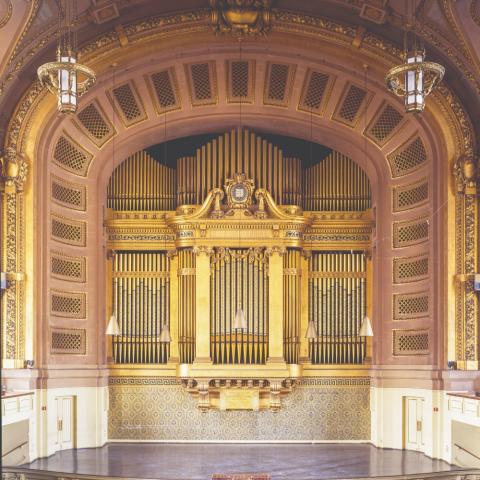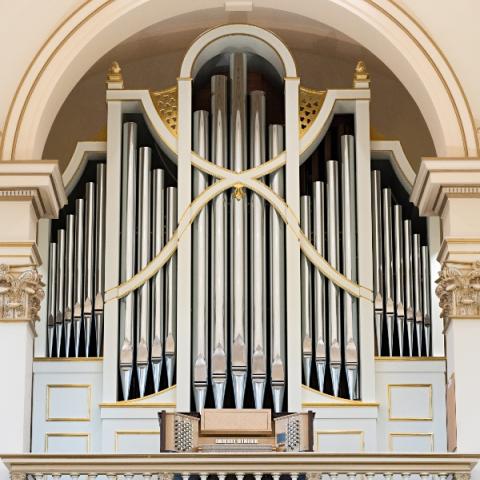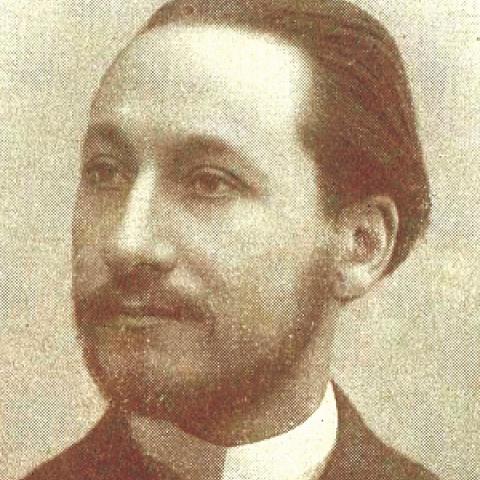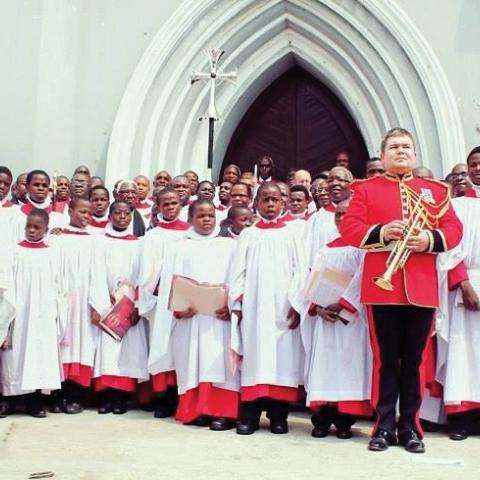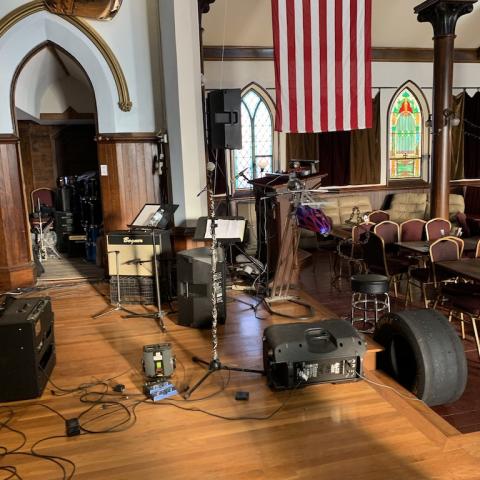Brian F. Gurley is the choirmaster and director of music at the Cathedral of the Immaculate Conception in Albany, New York.
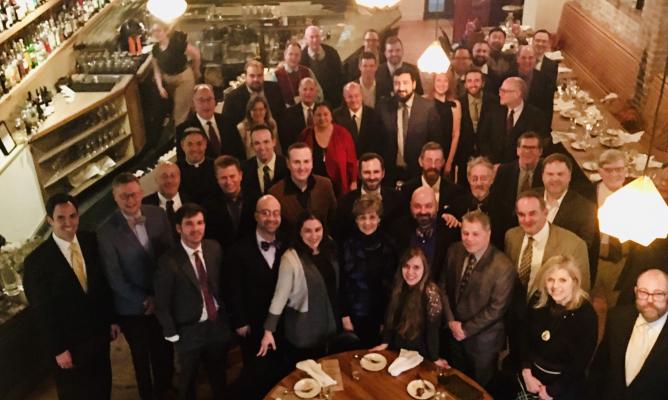
The Conference of Roman Catholic Cathedral Musicians (CRCCM) met at the Cathedral of Christ the Light in Oakland, California, for its thirty-seventh annual gathering. Rudy de Vos, director of music, designed and directed the gathering with John Renke, organist and director of cathedral operations; Denise Kogler, cathedral event operations manager; and the CRCCM steering committee.
Monday, January 6
The conference began with solemn Vespers at the cathedral with the Most Reverend Michael C. Barber, S.J., Bishop of Oakland, presiding. Organ music included La Nativité by Jean Langlais and Wie schön leuchtet der Morgenstern, op. 67, no. 49, by Max Reger. Choral repertoire included Magnificat in B-flat Major by Philip Moore and Who Comes by Leo Nestor.
The Cathedral of Christ the Light was constructed in 2008 in the late twentieth-century abstract style by Craig W. Hartman of the San Francisco-based architecture firm Skidmore, Owens, and Merrill. Notable architectural features of the cathedral include its footprint of a vesica piscis (a shape formed by the intersection of two circles of the same radius), which evokes the ichthys, a secret symbol of the early church; overlapping panels of rich Douglas fir, which allow light to filter in gently throughout the cathedral; and a stunning pixelated icon of the Christus Pantocrator, a copy of an image from the Cathedral of Notre Dame de Chartres, in France. The Cathedral of Christ the Light is home to the Conroy Memorial Organ, a four-manual, ninety-rank instrument built by Orgues Létourneau, Limitée, in 2010.
After Vespers, the cathedral hosted a reception in the Events Center. Rudy de Vos welcomed everyone to Oakland; Brian Luckner, chair of the CRCCM steering committee, read the CRCCM Statement of Purpose; and conference participants introduced themselves.
Tuesday, January 7
On Tuesday morning at the cathedral, following Morning Prayer, the Very Reverend Brandon Macadaeg, rector of the cathedral, gave a brief tour and outlined the history of the cathedral and the Diocese of Oakland. The morning itinerary continued with a presentation by Crista Miller, director of music at the Co-Cathedral of the Sacred Heart in Houston, Texas, titled “Held in High Esteem: Cathedral Pipe Organs of the 21st Century and a Brief Survey of Their Community Impact.” Miller expounded on the general liturgical responsibilities of cathedral musicians, their opportunities for evangelization, community arts outreach, and pedagogy. She presented a map of the United States, pinpointing forty-three organ installations among 193 Catholic cathedrals and drew connections to contemporary church documents and events relevant to liturgy and music. Miller described organbuilding projects as the musical monuments of cathedral musicians as a “community of practice,” drawing on the educational work of Étienne Wenger. She exhorted her colleagues to insist on the usage of the organ in the liturgy and the performance of organ repertoire, for the sake of exposing church goers to the instrument; she advocated consistent incorporation of congregational hymn singing in the liturgy, for the sake of exposing church goers to beautiful vernacular hymn texts and common practice harmony; she called for new organ projects in southern cathedrals, including a process copy instrument reflecting the rich organ building tradition of Latin America; and she called for an increase in the voices of women and minorities in the community.
Following a coffee break, Bishop Barber delivered his address, “The Urban Cathedral in the 21st Century.” Bishop Barber touched on the challenges of financing and constructing a modern cathedral, making mention of services such as the Malta Medical Clinic and the Pope Francis Legal Clinic; these demonstrate assistance to the poor while committing significant financial resources to new construction. He articulated his understanding of the mission of the Catholic Church: to create a place where people can encounter Jesus Christ, and where Jesus Christ can meet His people.
For Bishop Barber, this plays out through three practical priorities: the Sunday experience (including beautiful sacred music, intelligent preaching, and sincere fellowship), carrying out corporal and spiritual works of mercy, and the formation of missionary disciples. He underscored that the most important of these practices is the Sunday experience, the Mass, because it is “the place par excellence where we encounter Jesus Christ in the spoken Word, but especially in the Holy Communion, the Holy Eucharist; and people won’t even know there’s something spiritual going on there unless you create that atmosphere, that place where they’re drawn in, and they feel uplifted in heart and soul.” Bishop Barber also addressed the widely debated term “active participation,” advocating a both/and approach to liturgical music, including congregational hymns and refrains as well as choral music that engages the listening dimension of participation. He shared copies of the text of one of St. John Paul II’s ad limina addresses to American bishops, in which the pope discussed the nature of liturgical participation in light of conciliar reforms.
The afternoon sessions began with a talk, “Kinds of Liturgy and Kinds of Music,” given by William Mahrt, president of the Church Music Association of America. Mahrt briefly prefaced his talk by mentioning various church documents regarding music, as well as identifying types of sacred music that are not liturgical. He focused on Gregorian chant, highlighting the often-quoted statement from Sacrosanctum Concilium, giving Gregorian chant principum locum, or “first place” in the liturgy. Mahrt contended that the common English translation “pride of place” falls short of the original Latin, suggesting that “first place” recognizes the paradigmatic quality of Gregorian chant in the Roman Rite. He contextualized his discussion of chant in light of its special suitability to liturgy, its ability to draw the mind and heart of the listener to contemplate eternal verities.
Gregorian chant is “unambiguously sacred” to the point of sounding strange when divorced from the liturgy, such as in a concert setting; “it is not strongly metrical, and so does not represent something tied down to the passage of time, rather it has the ability to evoke something of the eternal, because of that kind of rhythm.” Mahrt highlighted Gregorian chant, arguing that its formal flexibility and ability to set appointed liturgical texts made it particularly well suited to liturgies. Examples of this flexibility would be the more syllabic and neumatic antiphons for processions or the largely melismatic chants for the graduals.
Regarding the graduals, Mahrt referenced Justus ut palma, in which final unaccented syllables of words are treated with extended melismas, so “the music, in some sense, departs from the text itself the most meditative possible way,” fulfilling the psalm meditation articulated in the General Instruction of the Roman Missal in a more compelling fashion. He called for serious attempts to cultivate sung Masses consistently, in order that the musical commentary given by chant might better accomplish the solemn and beautiful celebration of the liturgy, in contrast to the practice of progressive solemnity, which often entails quantitative changes in the sung elements.
In addition to his service to the Church Music Association of America, Mahrt is associate professor of music at Stanford University and director of the Saint Anne Choir at Saint Thomas Aquinas Parish in Palo Alto, California. The choir specializes in Gregorian chant and Renaissance polyphony.
The first of two CRCCM business meetings followed the address. The afternoon events continued with a composers reading session, during which conference participants had the opportunity to sing through new compositions from their colleagues.
That evening, David Briggs performed an organ concert in the cathedral. The program consisted of Briggs’s own transcription of the “Final” from Symphony No. 3 by Camille Saint-Saëns; Liebster Jesu, wir sind hier, BWV 731, and Pièce d’orgue, BWV 572, by Johann Sebastian Bach; “Andante sostenuto” from Symphonie Gothique, op. 70, by Charles-Marie Widor; Symphonie II, op. 26, by Marcel Dupré; and an original Tryptique Symphonique Improvisée on two submitted themes.
David Briggs is an internationally renowned organist, maintaining a performance schedule of over sixty concerts per year. He currently serves as artist-in-residence at the Cathedral of Saint John the Divine in New York City.
Wednesday, January 8
Following Morning Prayer at the cathedral, David Briggs taught a masterclass on improvisation. Organists who participated in the masterclass were Sebastián Modarelli, music director and organist, Co-Cathedral of Saint John the Evangelist, Rochester, Minnesota; Chris Ganza, choir director and organist at the Cathedral of Saint Paul, Saint Paul, Minnesota; Thomas Fielding, director of music and liturgy at Saint Augustine Cathedral, Kalamazoo, Michigan; and Daniel Sañez, director of music and liturgy at the Cathedral of the Sacred Heart, Richmond, Virginia.
Following the masterclass, Frank La Rocca delivered a presentation titled, “The Apologetics of Beauty: A Musical Theology of the Incarnation.” La Rocca discussed his creative processes as a composer of sacred music, and he referenced his setting of the antiphon O Magnum Mysterium to demonstrate certain compositional techniques. La Rocca addressed that the apologetics of beauty “appeals to the human person’s innate sense of the universal, of the mysterious, of the [spiritual]. A sense that is pre-rational, or perhaps super-rational, and therefore capable of being reached more directly, because it bypasses the skeptical intellect.” As a commissioned composer of sacred works intended for the concert setting, La Rocca reflected on his role of evangelization through beautiful music, even outside the liturgy. “Even in cultural contexts where relativism rules the day, and where people may not be responsive to appeals to truth or moral goodness, I am convinced they can nevertheless be engaged by the power of beauty. Because beauty is the visible form of the good, just as the good is the metaphysical condition of beauty. And where these two things correspond, there we find truth.” He proceeded to analyze his setting of O Magnum Mysterium textually, theologically, and musically, and he described the unique application of musical symbolism in this motet, influenced by his study of musical symbolism in the music of Johann Sebastian Bach. La Rocca is composer-in-residence at the Benedict XVI Institute for Sacred Music and Divine Liturgy.
After the presentation, conference participants attended daily Mass in the cathedral with Fr. Macadaeg, celebrant. Choral repertoire included “Kyrie” from Missa Quinti toni by Orlando di Lasso, Magi veniunt ab oriente by Clemens non Papa, Ubi caritas by Peter Mathews, and the mode I Gregorian Communion antiphon Manducaverunt. Organ voluntaries included “Desseins éternels” from La Nativité by Olivier Messiaen and Toccata on “Antioch” by Craig Phillips.
The second of the two business meetings followed, during which nominations were made for elections to the steering committee, per CRCCM bylaws. Brian Luckner discussed revisions to the bylaws as prepared by the steering committee, and electronic voting opened during the conference. Marc Cerisier, acting CRCCM treasurer, was recognized for his contributions to the organization, namely the maintenance of the CRCCM website; development of a membership database to streamline renewals and the publication of a directory; and his attention to administrative tasks.
The afternoon sessions continued with a roundtable discussion on chorister formation. Teri Larson and John Romeri were the principal presenters, describing approaches to chorister training in their cathedrals. Larson described a parish-based program that incorporates young singers into an intergenerational choral program. She made special mention of the training of young cantors, who enjoy serving with experienced adult cantors in liturgies at the Basilica of Saint Mary. Romeri described the diocesan-based model that he has established in his posts throughout his career. His diocesan model allows for recruitment of choristers from parishes throughout a given diocese, who rehearse together in preparation for major diocesan liturgies. The roundtable discussion concluded with a question and answer session and allowed other colleagues to share their experiences and ideas from their own chorister training programs.
Conference participants returned to the cathedral for an evening choral concert. The choirs of the cathedral presented a program titled, “21st Century Music in a 21st Century Cathedral.” The Cathedral Camerata and John Renke, organist, performed Missa Brevis (2019) by John Karl Hirten and Ave Maria (2009) by Frank La Rocca. The Cathedral Choir of Men and Boys, featuring the Pacific Boychoir Academy, performed Requiem (2003) by David Briggs. Briggs served as organist for the performance of his work. The concert was under the direction of Rudy de Vos, and all three composers were present for the concert.
Thursday, January 9
The Wednesday itinerary began with Morning Prayer at Saint Albert’s Priory, at the Dominican House of Studies for the Western Province. Following Morning Prayer, Reverend James Moore, O.P., addressed conference participants in a talk titled, “The Relationship between Cathedral Rector and Cathedral Musician.” Fr. Moore—a trained musician himself—demonstrated wisdom and credibility on this delicate topic, and he drew on experiences as a musician and as a priest. Regarding the formation of clergy, he discussed with candor the challenges of seminary formation, as well as how a priest’s formation in seminary (even experiences and formation before and after) might influence his interactions with staff in problematic ways. Fr. Moore also challenged musicians who struggle with detachment, encouraging them not to determine their self worth and personal dignity on the success of their music programs. After describing the challenges faced by clergy and musicians, he proposed regular communication to cultivate a deeper sense of collaboration and trust. Following the talk, Fr. Moore demonstrated the chapel organ, a two-manual, twenty-two-stop instrument, Opus 36, of Paul Fritts & Company Organ Builders, Tacoma, Washington, built in 2013. The Reverend James Moore, O.P., is Vicar Provincial for Advancement for the Western Province of Dominicans.
The closing banquet of the conference was held at the Mockingbird Restaurant in Oakland. Well-deserved appreciation was extended to Rudy de Vos, John Renke, Denise Kogler, Fr. Brandon Macadaeg, the cathedral’s administrative staff, and the CRCCM steering committee for organizing such a successful and enjoyable gathering. The 2021 meeting of the CRCCM will take place in Orange, California, hosted by Christ Cathedral.
Photo: CRCCM conference participants (photo credit: Brian F. Gurley)


